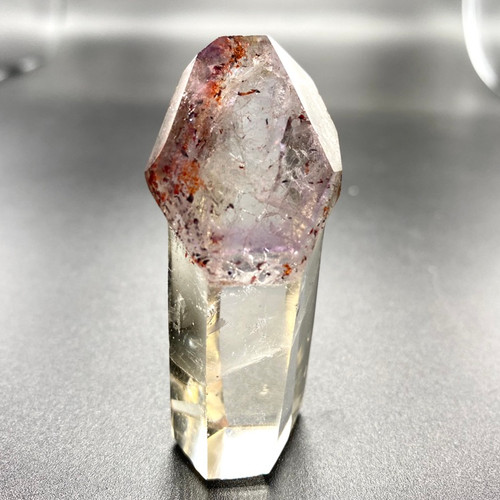"Fire Quartz" Scepter with Amethyst Point
Measures Approximately: 2 1/4" x 1" x 3/8"
Weighs Approximately: 1.7 oz
Oh golly. This is a different point. The scepter area has spangles of hematite that we call "fire quart", but it also has a very light amethyst outline around the raised point. Super interesting.
Amethyst is a purple variety of quartz. According to current theories exposure to natural underground radiation causes trace amounts of tetravalent iron (Fe4+) to replace some of its silicon. This change in its crystal structure creates its color. The name comes from the Greek amethystos (“not intoxicating”). People sculpted drinking cups out of amethyst in antiquity believing that it would prevent drunkenness.
Quartz is the most common of the silica minerals. The group is all composed of silicon dioxide but have different crystal structures. The others form under specific conditions like very high temperatures. The name quartz comes from the German quarz, without a “t”. It may be derived from the Polish kwardy (“hard”). Pure quartz is colorless but trace metal inclusions can color it purple (amethyst), yellow (citrine), and brown (smoky quartz). It also forms in fibrous varieties without visible crystals like chalcedony.
Hematite included quartz is ferruginous, colored red, yellow, or brownish orange by iron oxides like hematite and limonite. It may be natural or heated to enhance the color by reducing its water content like carnelian. The name is derived from the Greek haimatoeides (“resembling blood”). Hematite can express in several ways inside of quartz, such as dark gunmetal grey, black or red threads, spatters, or sparkly glitter. When the inclusion is red and sparkly, it has had the trade names of lepidocrocite, harlequin quartz, or fire quartz in the past. There are some popular metaphysical included quartz varieties that count these different expressions of hematite as their own distinct inclusions, even though it's all hematite. For example, there is a well known quartz that should technically now be called "Fabulous Five", instead of "Super Seven", but the metaphysical industry trade names don't tend to update when the accepted geology does.








